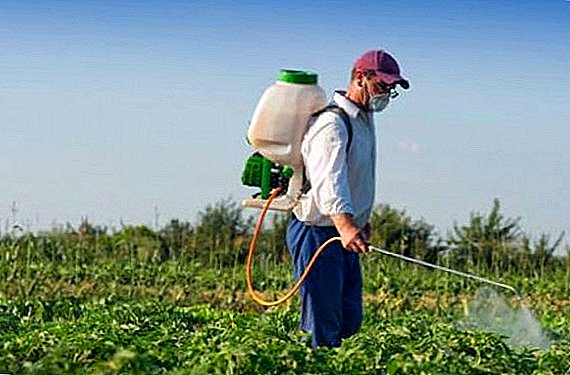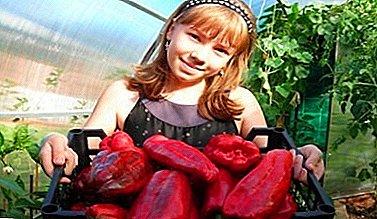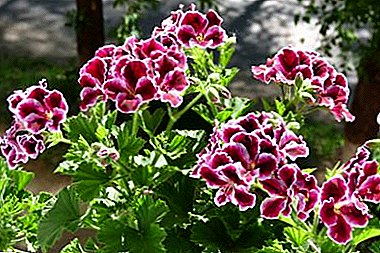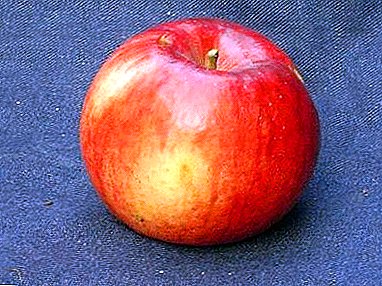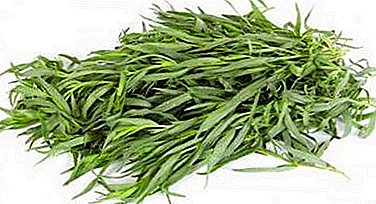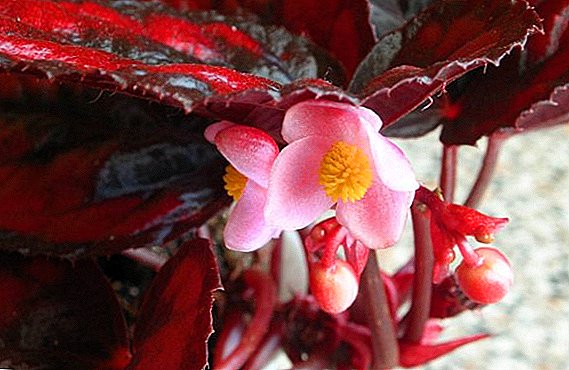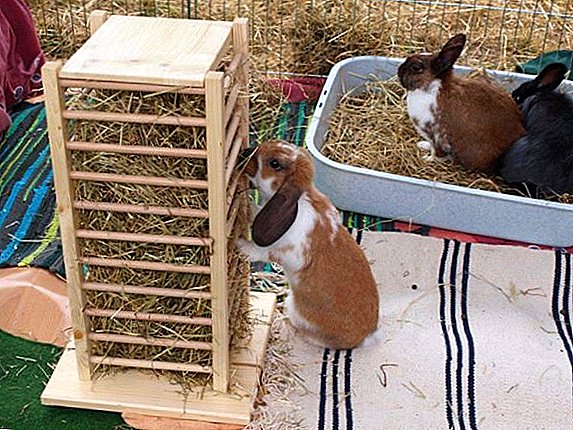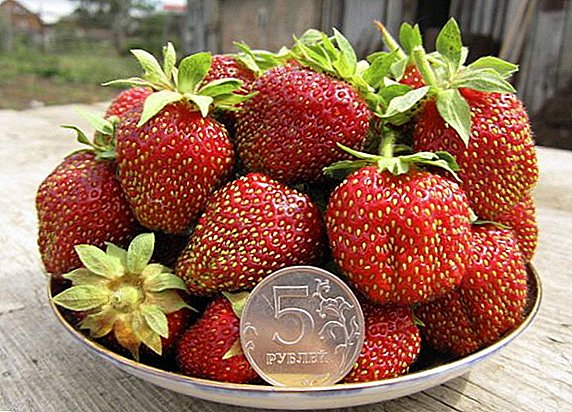 If you want to please yourself and all the home with fresh, delicious strawberries, then pay attention to the variety "Maryshka".
If you want to please yourself and all the home with fresh, delicious strawberries, then pay attention to the variety "Maryshka".
How it differs from other varieties, how to care for it, to get a healthy, large crop, and how to protect plants from pests - all this can be found further in the article.
Variety description
This strawberry variety was bred by Czech breeders, and it belongs to the medium early ones. A characteristic feature of the berries are consistently large fruit sizes. Gardeners isolate plant resistance to diseases and low ambient temperatures. It is worth noting that the presented variety has an excellent ability to reproduce, in view of which it is possible to purchase fewer bushes - the strawberry itself will grow in the section prepared for it.  This variety has been admired by gardeners and for its taste, as well as the rather dense texture of the berries, so that it can be easily transported over long distances for sale - this will in no way be displayed on the appearance and condition of the strawberry.
This variety has been admired by gardeners and for its taste, as well as the rather dense texture of the berries, so that it can be easily transported over long distances for sale - this will in no way be displayed on the appearance and condition of the strawberry.
Strawberries are also classified as medium-early varieties: “Asia”, “Black Prince”, “Crown”, “Masha”, “Vima Zant”.
Another feature of the "Maryshki" - the location of flower stalks. They, as a rule, are not under the foliage, but above it, which protects the crop from possible diseases. Also, it greatly facilitates the process of harvesting. The berries themselves are characterized not only by an appetizing appearance, but also by the ability to ripen at the same time - they become fit for human consumption on the same day.
Characteristics of berries and yield
As we said fruits "Maryshki" large - one strawberry has an average weight of at least 50 grams. The color of the berries is rich red, glossy, with yellow seeds. But the fetus has no specific form. This is due to the fact that the ripening berries fit tightly together, so the strawberries can be flattened or cone-shaped.
The taste qualities of strawberries pleasantly surprise: it is sweet, gentle, and at the same time not watery, but rather dry, which also has a positive effect on transportability.  Berries Marshki smell like forest strawberries
Berries Marshki smell like forest strawberries
Did you know? In the Middle Ages, strawberries (some of which we call strawberries) were considered dirty berries, because they grew close to the ground, and therefore could be poisonous due to the touch of snakes and toads.
On one bush can accommodate up to ten berries, respectively, the harvest from the bush is about half a kilogram. With one square meter you can get a harvest of over one and a half kilograms - since the plant grows quickly, it is desirable for it to allocate enough space and not plant more than three bushes on one square meter.
Agrotechnics of growing and caring for strawberries
The advantages of this variety of strawberries abound, but it is worth remembering that get a good harvest can only one gardener who carefully monitors the plant. In this regard, "Maryshka" does not cause much trouble, but we will tell you about the basic rules for planting and caring for bushes.
Check out the best varieties of large strawberries.
Selection of seedlings
Often the cause of many diseases or wilting of plants is the inability to choose the material for planting. Therefore, it is strongly recommended to pay attention to the appearance of seedlings - for planting, take those that look quite strong. But weak, damaged or with signs of disease, seedlings should be avoided, because they are unlikely to be able to develop and bring you at least some harvest.
VIDEO: HOW TO CHOOSE THE SEEDLANDS SEEDLINGS The roots of the seedling in height should be at least 7 cm, and the diameter of the root collar should be greater than 6 mm - these signs are characteristic of healthy, developed seedlings.
It is also best not to acquire planting material that has flaws in the form of shriveled leaves or white spots on the leaves. A healthy leaf has a rich emerald color.
Conditions of detention
It is also important the place where you plan to grow sweet berries. "Maryshka" prefers open space, without the presence of tall plants nearby - trees and shrubs, which will cast a shadow on the strawberries. Bushes are important access to sunlight, as planted in the shade, they will give a smaller crop, and the taste of berries will be less sweet.
Important! It is highly undesirable to be near tomatoes, eggplants, potatoes, peppers and other solanaceous crops next to the “maryshka”. All of them can become carriers of verticillosis and subsequently infect strawberry bushes with this disease.
 Excess moisture in the soil can also damage the health of the plant, so choose areas that are protected from flooding for planting seedlings. Damps can be made on wet ground or a mound can be made to protect strawberries from gray rot.
Excess moisture in the soil can also damage the health of the plant, so choose areas that are protected from flooding for planting seedlings. Damps can be made on wet ground or a mound can be made to protect strawberries from gray rot.
Soil and fertilizer
Ideally, loamy soils are suitable for “Maryshki”, the acidity of which is within 5.5-6. Before planting seedlings, it is necessary to fertilize the soil.
If you are going to plant "Maryshka" in the spring, then the soil treatment should be carried out with the help of organic and mineral fertilizers.
On an area of one square meter you will need the following:
- humus - half a bucket;
- potassium chloride - 20 grams;
- superphosphate - 60 grams.
Feeding "Maryshki" must be made to the second year after planting seedlings. For this, a solution is prepared on the basis of mullein (1 part) and water (4-5 parts).
Important! Preparation of soil for spring planting of seedlings should be carried out in the autumn months, and for the autumn, respectively, in the spring.

Strawberries can become not only a tasty delicacy, but also a decoration of your plot, if you build a vertical bed or a pyramid bed from it.
You can replace it with nitrophoska - only one tablespoon of fertilizer is needed for 10 liters of water. Water the bushes once every ten days with the prepared solution. It is necessary to carry out this procedure in the spring, until flowers appear on the bushes. As soon as this happens, strawberry feeding should stop.
Watering and moisture
You already know that excessive moisture can harm the little "Maryshka", but this variety is not drought resistant. Watering strawberries should be given special attention - it matters and the time of watering, and even water temperature.
In the first week after planting you need to water the bushes every day. For one square meter you will need from two to three liters of water. For the second week after planting, it is necessary to reduce the flow of fluid to the rhizome and water the strawberries only once every seven days. In the opposite case, you risk to overpower the plant with moisture, as a result of which it will fall ill. This frequency of irrigation is typical for the spring-autumn period, in summer, in the heat, the plant needs to be watered once every three days, and with strong heat it can be done every other day. It is best to carry out this procedure in the early morning hours or evening, late.
Important! The temperature of the water for irrigation should be room temperature, not cold in any case. In addition, it is desirable to preserve the liquid in advance - pour it into a container so that it has time to brew properly.
 Drip irrigation of strawberries. Once the soil is saturated with water, you can clear the area of weeds and plow through the soil.
Drip irrigation of strawberries. Once the soil is saturated with water, you can clear the area of weeds and plow through the soil.
Relation to temperature
The presented variety tolerates low air temperatures, but it should be clarified that it is not suitable for northern areas - Siberia and the Urals. But in a temperate climate, strawberries will feel good and will easily endure the cooling and temperature drop.
We recommend to get acquainted with the best varieties of strawberries, which are suitable for growing in Siberia.
Reproduction and planting
An important condition for planting seedlings is soil temperature. It is necessary that she has time to warm up at least 5-6 centimeters. For this reason, planting strawberries in the spring is best in late April or early May, not earlier. Autumn planting is required no later than September.
Before placing the seedling in the soil, its roots need to be treated with a solution. For its preparation you will need a liter of water and 7 grams of "Agatha 25K". The latter can be replaced with 15 grams of "Humate K". In the resulting solution, dip the rhizome of seedlings.
Strawberry planting can be done in four ways:
- Handicraft With this method, two or three seedlings are placed in one hole at once. It is important when planting shrubs to keep the distance between them - at least 50 centimeters. This method is attractive because it is much easier for a gardener to get rid of excess antennae on a bush, and the crop grows many times larger and sweeter, since the plant receives quite a lot of light and solar heat. The disadvantage of this method is the need to more carefully care for the soil on which the strawberry grows - we will have to weed, loosen and mulch the soil more often.
- Rows. This option provides for the exposure of the distance between the planting material of 20 centimeters, between the rows you need to leave about half a meter.
- Nest. To grow one strawberry nest, you will need seven seedlings. Place one of them in the center, land the other six. In this case, the distance between all the seedlings should be at least 5 centimeters. Nests should be placed at a distance of 30 centimeters from each other, if they are in the same row. The aisle should be about 40 centimeters.
- Carpet. The essence of the method of landing is planting planting material in a free order. Since the “Maryshka” grows well, soon a strawberry carpet is formed on the site. This method is good if you do not have the ability to care for the plant constantly. The disadvantage of this method is a gradual decrease in the yield of bushes.

Check out the features of planting strawberries in spring and autumn.

Possible difficulties in growing
Even a beginning gardener will not have any particular difficulties with this variety. It is only important to pay attention to all the conditions for growing strawberries, comply with them and do not forget to take care of the plant in a timely manner.
Did you know? The first mentions of strawberries are found at the turn of the I-II centuries BC, and then it was the price of useful properties, and not taste.The only mistake that novice gardeners can make is the ability to water the “Maryshka” so that the bushes get enough moisture, but not overloaded with it.
Pests, diseases and prevention
One of the many advantages of the presented variety is its resistance to most diseases. However, do not relax - the right care of the plant has not been canceled. After all, it is thanks to him that you can avoid the possibility of infecting strawberries with those few ailments, resistance to which “Maryshki” is not observed.
One of these diseases is fungus. To avoid it, before planting seedlings in the ground, soak the sockets in the following solution: copper sulfate (1 part) and soda (6 parts). Ten liters of water will require 30 grams of this mixture.
Using copper sulphate in gardening should know what the consequences of poisoning with this substance.
Another disease that you may encounter when growing "Maryshki" is red root rot.  There is such a disease due to excess moisture in the soil, excessive watering or lack of ultraviolet radiation. To protect the bushes from red root rot, treat seedlings with a weak solution of fungicides. Already developed seedlings are recommended to inspect daily, so that you can notice changes in the appearance of the bush in time and remove infected bushes in time. This will prevent further spread of the disease.
There is such a disease due to excess moisture in the soil, excessive watering or lack of ultraviolet radiation. To protect the bushes from red root rot, treat seedlings with a weak solution of fungicides. Already developed seedlings are recommended to inspect daily, so that you can notice changes in the appearance of the bush in time and remove infected bushes in time. This will prevent further spread of the disease.
As for the parasites, then "Maryshka" has resistance to ticks. Pests in the form of weevil, whitefly and strawberry beetles can be eliminated if the plants are treated with Karbofos. Processing is best done on a dry, windless day. The temperature at the time of processing should not be above +15 ° C.  Summing up, we can say that the strawberry variety “Maryshka” is suitable for both an avid gardener and an amateur or beginner. The only thing that needs to be done to get a tasty, sweet harvest is to follow simple recommendations and not to forget that any plant requires care.
Summing up, we can say that the strawberry variety “Maryshka” is suitable for both an avid gardener and an amateur or beginner. The only thing that needs to be done to get a tasty, sweet harvest is to follow simple recommendations and not to forget that any plant requires care.
Reviews

Medium early variety, under cover easily goes to the finish line along with early varieties. The bush is low, compact.
It is often described as the sweetest and driest berry.
The berry is mainly medium-large, elongated. Sometimes there is a large rectangular (almost) shape.
Sunflower seeds (grains) on the surface are yellow-green in color, at the tip of the berries are their main cluster, therefore often, even with full ripeness, the tip has a greenish tinge.
Berry gains sugar content in any weather. If someone can wait for the burgundy color of the berries - the taste is indescribable. Personally, I taste the berries of this variety closest to the taste of wild strawberries.
The variety is resistant to complex diseases. He tolerates heat well, even if it is not water for a long time.
Just do not know how juicy the berries will be. if there is no watering during ripening.



